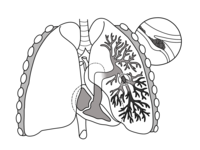
Photo from wikipedia
Introduction The 60/60 sign in 2D transthoracic echocardiography (TTE) a combination of pulmonary acceleration time (PAT) less than 60 milliseconds and tricuspid regurgitation (TR) jet gradient of less than 60… Click to show full abstract
Introduction The 60/60 sign in 2D transthoracic echocardiography (TTE) a combination of pulmonary acceleration time (PAT) less than 60 milliseconds and tricuspid regurgitation (TR) jet gradient of less than 60 mmHg has been found to be specific for the diagnosis of pulmonary embolism (PE). Materials and methods An observational prospective analysis was carried out on cases of suspected PE presenting to the emergency room (ER). TTE was performed on all cases with suspected PE prior to computed tomography pulmonary angiography (CTPA). Emphasis was placed on measurement of PAT and early systolic notching (ESN) on the pulsed wave (PW) Doppler of the pulmonary valve, TR jet gradient, right ventricle systolic excursion velocity (RV S’) by tissue doppler imaging (TDI), tricuspid annular plane systolic excursion (TAPSE), and right ventricle to left ventricle end-diastolic dimension ratio (RV:LV EDD) in modified parasternal short-axis view. These signs were taken as screening tests and compared to CTPA as the standard test. Patients were followed up until hospital discharge or death.
Journal Title: Indian heart journal
Year Published: 2020
Link to full text (if available)
Share on Social Media: Sign Up to like & get
recommendations!